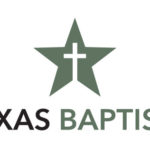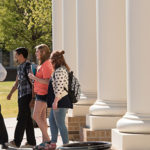PLAINVIEW—George May had never experienced racism. In fact, he was unfamiliar with its scope and practice. After all, where he was from, nearly everybody was black.
A native of San Andres, Colombia, May came to the United States in search of an education in 1950. His pastor, C.W. McCullough, a missionary in San Andres, recommended a small school in West Texas. But in an era of institutionalized segregation May initially was not allowed to enter Wayland Baptist College in Plainview.
|
George May, 82, the first black student to graduate from Wayland Baptist University, talks with Jordy Williams and Jordy’s fiancée, Rachel Morgan, following a Legacy Luncheon held on the Wayland campus. (PHOTOS/Wayland Baptist University)
|
May heard of ABT Seminary in Nashville, a school for black pastors affiliated with American Baptist College—founded in part by O.L. Hailey, a former president of Wayland. With his admission to Wayland blocked, May loaded a bus and struck out for Nashville, in search of an education. While at the seminary, May received a call from Wayland President Bill Marshall.
“He called me and asked me to return the following year,” May said.
In 1951, Wayland Baptist College became the first four-year, liberal-arts college in the formerly Confederate South to integrate voluntarily when the school admitted Annie Taylor, a teacher from Floydada, to take summer courses. May and classmate Bonnell Williams were the first black students to enroll full-time at Wayland. In 1953, May became the first black student to graduate from a Baptist college in Texas.
May’s hunger for a formal education developed early. As a young boy in San Andres, May would spend his free time at his pastor’s home. He ran errands and did odd jobs for the pastor, and he would spend his free time reading the pastor’s magazines from the United States.
“I did not have access to magazines from outside,” May said. “It was a delight to just sit around and read.”
Getting admitted into Wayland was the first hurdle May had to clear, but it wasn’t the last.
“My second problem was, where do I go to get my hair cut?” he said. “I didn’t know where to go. I didn’t know where to find the black community. I went to the barber adjacent to the campus, and he slammed the door on me.”
Sign up for our weekly edition and get all our headlines in your inbox on Thursdays

George May (right) stands with classmate Bonnell Williams and Wayland Baptist College President A. Hope Owen at graduation in 1953. May, whose name came before Williams alphabetically, was the first black student to graduate from Wayland. (PHOTOS/Wayland Baptist University)
|
Marshall heard about May’s haircut experience and visited the young student in his dorm room that evening.
“He said, ‘George, by this weekend we will have our own barber shop,’” May said. “I was very humbled by his humility.”
Sure enough, Wayland opened a barber shop in the basement of the administration building to cater to students of all races.
May said he and Williams also created a dilemma for the Baptist churches in town.
“They didn’t know what to do with these two black kids coming to their churches,” he said. “Their pastors and deacons all met, and the decision was that one of us would go to College Heights and the other to First Baptist Church. I went to College Heights.”
It’s been 58 years since May began breaking barriers to further the cause of education. Now, at age 82, he is at it again. Upon graduating from Wayland, May embarked on a career in ministry that saw him serve as pastor of his home church in San Andres as well as churches throughout Texas and into Ohio. In 1972, May teamed with his former mentor, McCullough, to co-pastor the South Park Baptist Church in Houston where he served 20 years.
In 1993, May returned to San Andres and his home church, where he served his third stint as pastor. While there, he became increasingly aware of the need for education among the people of San Andres. In 1998, May opened the Christian University of San Andres. The school operated from 1998 to 2003, graduating approximately 70 students. But the school fell on hard times as funds dried up and a building project sits incomplete.
May now spends his time trying to raise money for the school that could mean so much to his native island. Nearly 75 percent of San Andres’ population is unemployed. May believes a quality education can help bolster the economy of San Andres.
“Kids here have problems and with higher education we could help them,” he said. “With education they could set up their own businesses and become productive.”
Christian University of San Andres is currently an unused, unfinished building, sitting on about 20 acres of land donated by May. The school’s founder speaks to groups and other colleges and universities trying to raise awareness of the needs of the people of San Andres—and raise money to support the school.
“It is estimated that we are going to need to raise $3 million to put it in good order. To complete the building and maybe start another building,” he said.
May remains in good health. He exercises every day and takes his medication, and as long as he is able, he will be working to further the cause of the Christian University of San Andres.
“We live in hope,” he said.














We seek to connect God’s story and God’s people around the world. To learn more about God’s story, click here.
Send comments and feedback to Eric Black, our editor. For comments to be published, please specify “letter to the editor.” Maximum length for publication is 300 words.